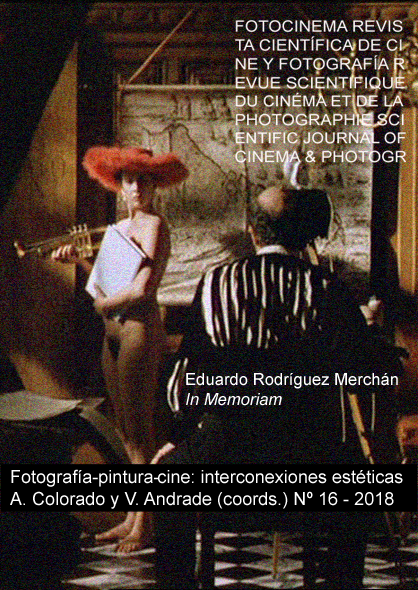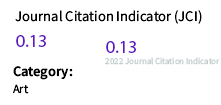Two interpretations of (the same) space. Mythic north american landscape in film (Badlands, Terrence Malick 1973) and photobook (Redheaded Peckerwood, Christian Patterson, 2011)
DOI:
https://doi.org/10.24310/Fotocinema.2018.v0i16.4118Keywords:
Badlands, Terrence Malick, Redheaded Peckerwood, Christian Patterson, Photobook, Mythic Landscape, SpaceAbstract
This article analyzes North American landscape in Terrence Malick's Badlands (1973) film and Christian Patterson’s Redheaded Peckerwood (2011) photobook. These are two interpretations of a real case: the murders committed by Charles Starkweather and Caril Ann Fugate and their getaway through the American Midwest. A comparative dialogue between cinema, photography and the book reflecting the specificity of each medium is established.
Downloads
Metrics
Publication Facts
Reviewer profiles N/A
Author statements
Indexed in
-
—
- Academic society
- N/A
- Publisher
- Universidad de Málaga
References
Batchen, G. (2004). Arder en deseos. La concepción de la fotografía. Barcelona: Gustavo Gili.
Bauman, Z. (2010). Vida líquida. Barcelona: Paidós.
Bazin, A. (1990). ¿Qué es el cine? Madrid: Rialp.
BFIEvents (2014). Sam Mendes on Paris, Texas. [Video YouTube]. Recuperado de: [https://www.youtube.com/watch?v=0saAAxY4rn8].
Bignell, J. (2005). From detail to meaning: Badlands (Terrence Malick, 1973) and cinematic articulation. En Gibbs, J. & Pye, D. Style and Meaning: Studies in the Detailed Analysis of Film. Manchester y Nueva York: Manchester University Press.
Bonnemaison, J. (2004). La géographie culturelle. París: Éditions du C.T.H.S.
Bright, D. (1985). Of Mother Nature and Marlboro Men. An Inquiry Into the Cultural Meanings of Landscape Photography. Exposure, 23 (1). Recuperado de: http://www.deborahbright.net/PDF/Bright-Marlboro.pdf
Campany, D. (2014). The “Photobook”: What’s in a name? The PhotoBook Review, (7). Recuperado de: http://aperture.org/blog/whats-name-david-campany/
Campbell, N. (2012). The Highway Kind: Badlands, Youth, Space and the Road. Patterson, H. The Cinema of Terrence Malick: Poetic Visions of America. Columbia University Press.
Correa, J. (2006). El Road Movie: Elementos para la definición de un género cinematográfico. Cuadernos de música, artes visuales y artes escénicas, 2(2), 270-301.
Cotton, C. (2005). The Photograph as Contemporary Art. Londres: Thames & Hudson.
Dennis, K. (2005). Landscape and the West: Irony and Critique in New Topographic Photography. In Cultural Landscapes in the 21st Century (pp. 1–7). Recuperado de: http://www.ncl.ac.uk/unescolandscapes
Douglass, W. J. (1981). The criminal psychopath as Hollywood hero. Journal of popular Film and Television, 8(4), 30-39.
Elsaesser, T. y Hagener, M. (2015). Introducción a la teoría del cine. Madrid: UAM Ediciones.
Emerson, J. (2011). Opening Shots: Badlands. En Rogerebert.com. Recuperado de: http://www.rogerebert.com/scanners/opening-shots-badlands
Frasca, G. (2001). Road Movie. Immaginario, genesi, struttura e forma del cinema americano on the road. Torino: UTET Libreria.
Gilbey, R. (2008). The start of something beautiful. En The Guardian. Recuperado de: https://www.theguardian.com/film/2008/aug/22/drama
Giménez, G., & Lambert, C. M. H. (2007). El desierto como territorio, paisaje y referente de identidad. Culturales, 3(5), 7-42.
Glucksmann, A. (1964). Les aventures de la tragédie. En Bellour, R. (ed.), Le Western. Paris: Gallimard, 1993.
González Sánchez, J. F. (2010). La trama maestra en la narrativa audiovisual. El caso del cine del oeste. Fonseca, Journal of Communication, (1), 100-122.
Hayles, N. K. (2004). Print is flat, code is deep: The importance of media-specific analysis. Poetics Today, 25 (1), 67-90.
Kenyon, K. (2014). American Dreamers: Badlands’ Kit Carruthers and Holly Sargis. En Bright Lights Film Journal. Recuperado de: http://brightlightsfilm.com/american-dreamers-badlands-kit-carruthers-holly-sargis/#
Kolker, R. (2000). A Cinema of Loneliness. Nueva York: Oxford University Press.
Library of Congress (2016). Complete National Film Registry Listing. Consultado el día 7 de novimbre de 2016: https://www.loc.gov/programs/national-film-preservation-board/film-registry/complete-national-film-registry-listing/
López Silvestre, F. (2003). Por una historia comprensiva de la idea de paisaje: apuntes de teoría de la historia del paisaje. Quintana: revista de estudios do Departamento de Historia da Arte, (2), 287-303.
López Silvestre, F. (2004). El paisaje virtual. El cine de Hollywood y el neobarroco digital. Madrid: Editorial Biblioteca Nueva.
Maher Jr, P. (s.f). Terrence Malick, Badlands and Caril Fugate: An Interview. En Empty Mirror. Recuperado de: http://www.emptymirrorbooks.com/features/film/terrence-malick-badlands-and-caril-fugate.html
McArthur, J. (2012). Pro Bono: The 18 Year Defense of Caril Ann Fugate. Burbank: Bandwagon Books.
Michaels, L. (2009). Terrence Malick (Vol. 125). University of Illinois Press.
Monahan, Mark (26 de julio de 2003). Film-makers on film: Bill Paxton. En The Telegraph. (http://www.telegraph.co.uk/culture/film/3599290/Film-makers-on-film-Bill-Paxton.html).
Newton, M. (1998). Waste Land: The Savage Odyssey of Charles Starkweather and Caril Ann Fugate. Pocket Books.
O’Hagan, S. (2011). Christian Patterson goes on the trail of America’s natural born killers. Recuperado el 27 de febrero de 2017, de: https://www.theguardian.com/artanddesign/2011/dec/01/christian-patterson-photos-redheaded-peckerwood
Orueta, A. G. (2012). La consideración del espacio geográfico y el paisaje en el cine. Scripta Nova: revista electrónica de geografía y ciencias sociales, (16), 403.
Palacios, J. (2001). Psychokillers: anatomía del asesino en serie. Madrid: Ediciones Temas de Hoy.
Sandweiss, M. A. (2002). Print the legend: photography and the American West. Yale University Press.
Schulz, B. (2009). National Identities. The Synthesis of the Urban and the Rural in the Work of Charles Sheeler. En Modern Life. Edward Hopper and His Time (pp. 56–63). Múnich: Hirmer Verlag.
Sekula, A. (1986). The Body and the Archive. October, 39(Winter), 3–64.
Stam, R. & Spence, L. (1985). Colonialism, Racism, and Representation: An Introduction. En Nichols, B. Movies and Methods. An Anthology. University of California Press.
Steyerl, H. (2014). Los condenados de la pantalla. Buenos Aires: Caja Negra Editora.
Straehle Porras, E. (2012). El mito como excusa: diferentes usos del western. Sesión no numerada: revista de letras y ficción audiovisual, (2), 203-220.
Walker, B. (1975). Malick on Badlands. Sight and Sound, 44, 2, 82–83.
Ward, L. (2014). Outside Valentine: A Novel. Henry Holt and Company.
Wilson, A. (1992). The Culture of Nature: North American Landscape from Disney to the Exxon Valdese. Blackwell.
Downloads
Published
How to Cite
Issue
Section
License
All contents published in Fotocinema Revista científica de cine y fotografía are protected under the Creative Commons Attribution-NonCommercial-ShareAlike 4.0 International (CC BY-NC-SA 4.0) license. All about this license is available in the following link: <http://creativecommons.org/licenses/by-nc-sa/4.0>
Users can copy, use, redistribute, share and exhibit publicly as long as:
- The original source and authorship of the material are cited (Journal, Publisher and URL of the work).
- It is not used for comercial purposes.
- The existence of the license and its especifications are mentioned.
There are two sets of authors’ rights: moral and property rights. Moral rights are perpetual prerogatives, unrenounceable, not-transferable, unalienable, imprescriptible and inembargable. According to authors’ rights legislation, Fotocinema. Revista científica de cine y fotografía recognizes and respects authors moral rights, as well as the ownership of property rights, which will be transferred to University of Malaga in open access. The property rights are referred to the benefits that are gained by the use or the dissemination of works. Fotocinema. Revista científica de cine y fotografía is published in an open access form and it is exclusively licenced by any means for doing or authorising distribution, dissemination, reproduction, , adaptation, translation or arrangement of works.
Authors are responsable for obtaining the necessary permission to use copyrighted images.














13.png)



